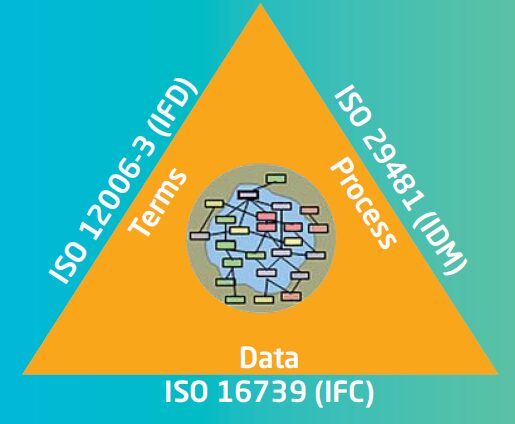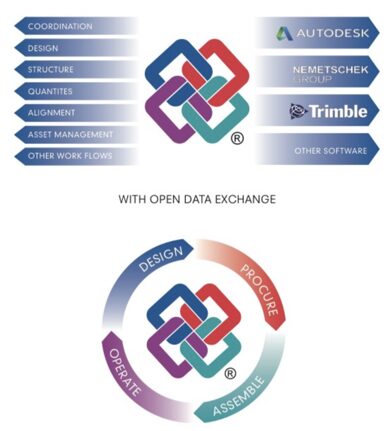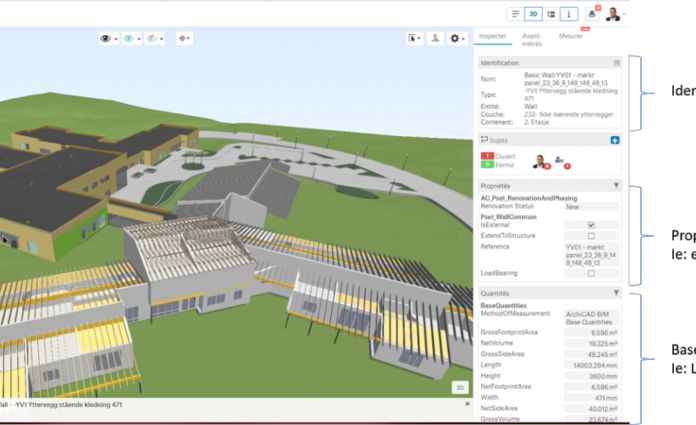The birth of the buildingSMART IFC format
In 1996 11 partners created the IAI (International Alliance of Interoperability) which became buildingSMART International – bSI in 2008.
The objective was to enhance interoperability during the complete lifecycle of a built asset by:
- Being neutral and open
- Addressing all the stakeholders collaboration needs in the construction sector
- Providing open standards
The first standard developed by BSI has now become an ISO Standard: ISO 16739-1:2018 Industry Foundation Classes (IFC) for data sharing in the construction and facility management industries – Part 1: Data schema.
At first, dedicated to buildings, IFC is in constant improvement and now addresses the whole construction sector with the addition of bridges and soon to come rails, roads, tunnels…
The IFC standard is the basis of the BIM ecosystem triangle from BuildingSMART International (Data, Process, and Terms).

The definition of IFC
Formally, IFC are both a conceptual data schema and an exchange file format structure.
The conceptual data schema formalism is derived from STEP (Standard for the Exchange of Product Data Model – ISO 10303) and specified in EXPRESS data specification language. An XML schema generated from the EXPRESS schema is also provided.
An IFC file can be exchanged as .ifc, .ifcxml, .ifczip (compressed file).
The object model is composed of objects – named entities (construction elements and containers elements) and relationships describing the interactions between the objects (for example the relationship IfcRelConnectsElements can be used to express the connexion between 2 walls). The current IFC version (IFC 4.2) is composed of 816 entities.
Of course, IFC are not describing only geometry but much more than that. Here we are talking about semantics, in a Building Information Modeling (BIM) process, we are not only exchanging geometry but also data. Right now, information attached to an object is described in Property Sets. A Property Set is the placeholder where to defined properties can be attached to any entity within the IFC model. The current IFC version contains 415 Property Sets. As all properties defining construction industry concepts worldwide cannot be defined in the IFC standard, a data dictionary such as the bSDD is more and more used to settle a single source of truth. This will be explored in more detail in another article dedicated to semantics.
What does an IFC file contain?
When receiving an IFC file, the universal approach to check the content of the Building Information Model is to use an IFC viewer. An IFC viewer can only read IFC openBIM files whereas some BIM viewers are able to read other proprietary BIM formats such as Revit, Archicad, Tekla…
The viewer will allow seeing the geometry but also all the information attached to each object composing the model. It is thus easy to verify:
- The geometry, shapes, connections
- the values of properties dedicated to thermal calculations
- the values of properties dedicated to structural calculations
- all the quantities needed to cost estimation
- all the properties dedicated to environmental impact calculations

Why use IFC in a construction project?
By using an open and standardized format, all the stakeholders involved in a construction project are able to describe and structure the information in a common way.
In a construction process, all the project participants will use and enrich the information relative to the project in their own specific tools. Without a standardized way of sharing the information (ie using proprietary formats), the data has been entered manually in all those tools, and many times; thus there is no way of sharing this information during the whole lifecycle of a built asset.
Nowadays, the use of a Common Data Environment (CDE) in a construction project has become widespread. Using a platform IFC (Industry Foundation Classes) compliant allows all project participants to share information in a common, open and standardized way; whatever is the software used to author, read, enrich content, if it is IFC compliant there is nothing more than uploading/downloading IFC files to access and use the information.
Another huge interest in using the IFC format is that users are not dependent on the versioning of software with new file formats for almost every version. When opening a file 10 years later, a software solution compliant with the IFC open standard will still be able to understand the information.
Finally and maybe even more important, IFC are in constant evolution to address the needs of the market and all the improvements are made under the control of construction professionals.
As openness is one of the pillar values of Catenda, we have chosen to use IFC as the format supported by Catenda Hub (previously Bimsync).

Is the market ready for open BIM standards and IFC?
Most of the common software used in the construction sector are already IFC compliant.
buildingSMART International provides a certification process for software vendors.
buildingSMART also provides a professional certification program to enable learning organizations to educate and certify individuals according to a recognized global learning framework. With this Program, buildingSMART provides a global benchmark for open BIM competency assessment. More to learn at https://education.buildingsmart.org/
Catenda Hub supports IFC format by offering a powerful viewer and seamless integrations for Open BIM Collaboration
Catenda Hub is a cloud-based common data environment (CDE) designed to streamline project management for construction and infrastructure professionals. It empowers seamless collaboration through open BIM (Building Information Modeling) standards.
Powerful IFC Viewer for Rich Project Insights
Catenda Hub leverages the IFC format, a widely used open standard, to provide a robust and interactive 3D model viewer. This viewer unveils the full potential of your project by:
- Enabling users to navigate and interact with 3D models enriched with semantic data stored in IFC files.
- Offering a comprehensive overview of all project models, fostering informed decision-making.
Seamless Integrations for a Unified Workflow
Catenda Hub prioritizes open collaboration by facilitating integration with common AECOO industry software tools via IFC and international standards. This creates a centralized data environment where project participants, regardless of their preferred software, can:
- Share project information in a standardized format.
- Utilize and contribute to the same data pool, ensuring everyone is on the same page.
Learn more about a case study exploring the role of IFC files and how Catenda Hub can be leveraged to address real challenges in a special project in Norway.
Catenda Hub is dedicated to fostering a truly open environment for BIM collaboration. By promoting open standards and seamless integrations, it empowers efficient project execution and paves the way for a more collaborative future in the construction industry.
Frédéric Grand, Catenda.




